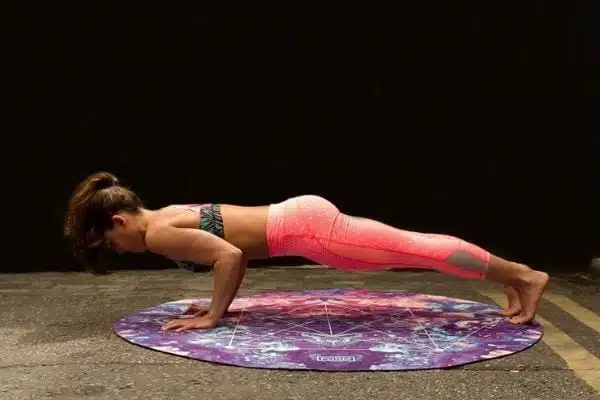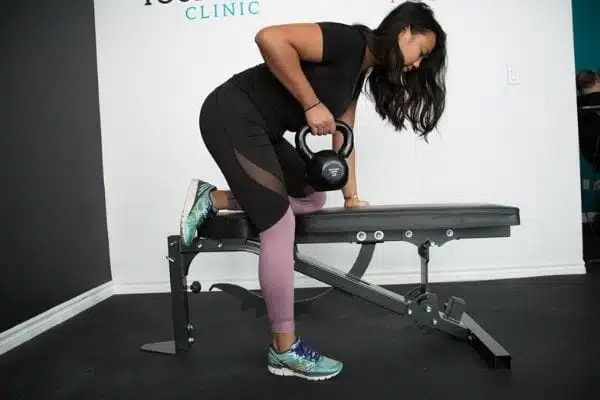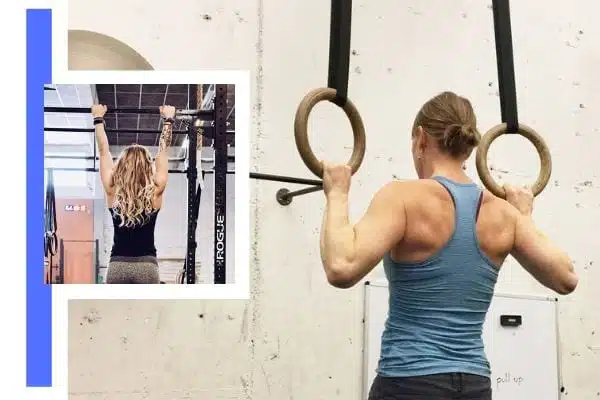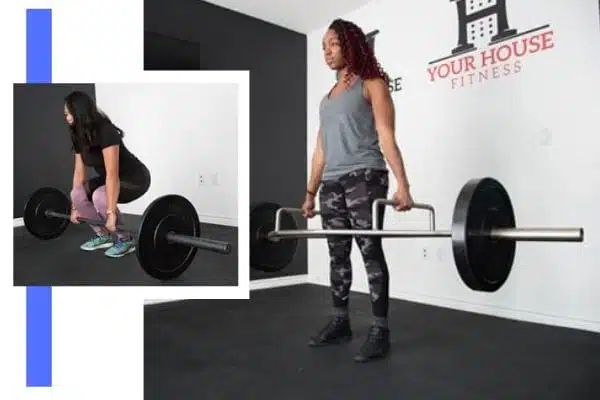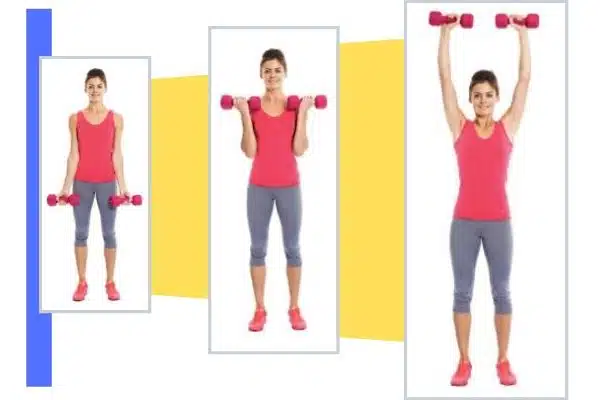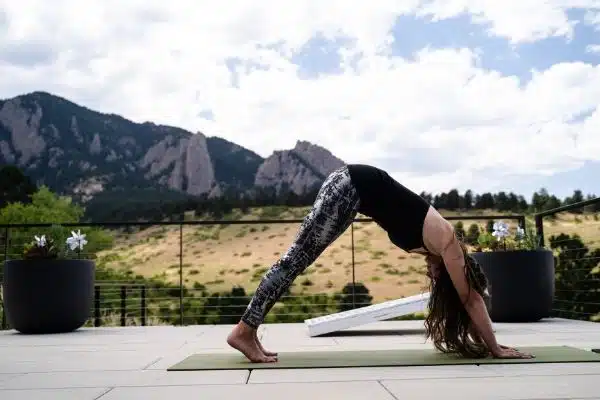Strength training exercises are designed to incorporate your core muscle groups by exerting resistance against the core muscles you’re trying to target.
Core Points!
- Strength training doesn’t always need to include additional equipment – using your bodyweight is just as effective!
- Focusing on one major muscle group at a time and cycling different muscle groups throughout your weekly routine will keep you on track while allowing rest and healing.
- Start with lesser resistance/weight and focus on more reps – as you build strength, add in more resistance for the same amount of reps.
- Power yoga is an especially effective bodyweight exercise for strength training. What’s even better, you don’t need any equipment. WIN-WIN!
It is important, and also recommended, to use proper resistance and weight that will engage your chosen muscle groups eventually forcing them to fatigue.
You’ll want to do so with multiple repetitions of 6 to 20 depending on the weight and/or resistance you are using. Beginners normally start out around 6 to 8 total exercises that focus on your body’s major muscle groups. You’ll also want to start out doing strength training exercises at least 2 to 3 times a week as you continue to build your strength and stamina. Over time, you’ll begin to lift more weight at higher reps and your body will naturally tone up and grow stronger.
Interestingly, if you haven’t tried yoga yet, you’ll see that power yoga classes, like the ones at Bulldog Online, provide fantastic strength training exercises through the use of body weight 💪🏽. You’ll also get the bonus of a great cardio workout and stretching.
According to Men’sHealth, the toughest step to make is the first one … and it’s usually the most rewarding!
Our power yoga classes will get moving and sweating in just 30 mins!
Strength training through yoga has never been easier and more fun! SAMPLE A KICK-ASS FITNESS CLASS! 😎
Here Are Some Simple (But Effective) Strength Training Exercises
1) Plank
A plank is a good standard exercise to include in any workout routine. It’s known for being a core exercise, but it’s just as useful for strength training because of the physical strength (in your core, arms, and legs) to hold yourself up. If you’re comfortable with traditional planks, you can try doing a variation to improve your strength and stability in your workout routine.
Some common plank variations include the side plank, leg-lift plank, and forearm plank.
How to do a plank…
A standard plank is the “up” position in a push-up. With your back straight, hold yourself up with your feet (legs straight) and hands (arms straight).
Pull your navel toward your spine to engage that core!
Slight Variation (Pictured Above)
To make it even tougher, you can try bending your arms and tuck your elbows to your sides.
This is difficult but will help strengthen your shoulders and arms at the same time.
2) Squats
Squats are another in our group of strength training exercises. Like a plank, you can do variations on a squat, including adding free weights, squatting deeper, or moving slower to engage your muscles.
These variations can help increase your strength through the exercises.
How-to: Do a squat…
Start in a standing position with your feet about shoulder-width apart and your arms down at your sides. Bend your knees and hips to lower your torso toward the ground while keeping your back straight. As you lower your body, lift your arms up in front of you so they are parallel to the ground. Return to a standing position with your arms down.
You did one squat!
Now repeat and try to hit 20 reps. If you can’t at first, that’s totally fine. You continue to build up those core leg muscles over time.
Just keep at it. Try to fit these workouts in when you can during your day.
Slight Variation (Pictured Above)
To make it even more of a workout, add in a resistance band.
Just step on one side with both feet and push up with the other side making sure to stay stable and controlled.
Related Article – Yoga Workouts with Resistance Bands
3) Bent-over Row
A bent-over row uses your upper-body muscles as you lift weights, but it also requires that you engage your core and leg muscles to stay in a stable position during the exercise.
One of the advantages of this exercise is that you can increase your strength by using a higher weight free weight in your exercise.
How-to: Do a bent-over row.
Begin in a standing position with your feet approximately shoulder-width apart and your arms down at your sides.
You should have one free weight in each hand. Bend your knees slightly and bend your torso forward, keeping your back straight, until it is parallel to the ground and your arms are still hanging down toward the ground.
Bend your elbows of both arms and bring your hands toward your shoulders, keeping your elbows close to your body, then straighten your arms again. This is one rep.
Slight Variation (Pictured Above)
You can use a bench or a chair works as well.
With a weight in your right hand, rest your left knee on the bench and bend over so that you’re leaning forward.
Start with your right arm extended then pull your arm back so that your elbow is tucked by your side bringing the weight to the right of your chest.
Slowly release and repeat.
Do this about 20-30 times depending on your weight. Try to do about 3 sets of these to really get those arms, shoulders, and back burning.
4) Pull-up
A pull-up is a bodyweight exercise that engages your entire body to be successful.
No real equipment is needed except a bar to pull up on, which makes this a good exercise that can be done pretty much anywhere.
You can also incorporate variations of a pull-up for further training, such as adding ankle weights, changing your hand/arm position, or increasing your speed and reps.
How-to: Do a pull-up.
Begin by hanging from the bar with your arms straight.
Pull yourself up to the bar with your arms until your head is above the bar, then lower your body again until your arms are straight.
This is one pull-up.
Slight Variation (Pictured Above, Right)
Instead of using a solid bar, you can substitute that stability with two individual rings or straps to add an extra workout boost.
This is when you’re ready to hit that next level in your advanced workout routine.
5) Deadlift
A deadlift is a great strength-training exercise that works your back muscles.
Since this is a weight-lifting exercise, you can increase your strength by adding weight periodically.
Just make sure that you start slow, and it may be a good idea to have someone nearby to spot you, especially if you’re new to deadlifting.
How-to: Do a deadlift.
Stand behind the barbell with your feet about hip-width apart. Bend at the hips and knees to lower your torso toward the barbell.
Grab the barbell, keeping your arms straight, and push your butt out so your torso is almost parallel to the floor.
Push through your heels and stand up straight, keeping your arms straight and the barbell close to your legs as you lift it.
After holding the barbell in this position for a few seconds, slowly lower it back to the floor in the same way you bent to pick it up.
This is one rep.
6) Bridge
A bridge is a good way to strengthen the lower half of your body as well as to strengthen your core. You will see bridge pose in many of our online yoga classes. You can add variations to make a bridge more challenging, such as lifting a leg when in the bridge position.
How-to: Do a bridge.
Begin by laying flat on your back and your feet on the floor (knees bent).
Lift your hips, keeping your feet in place, until your thighs and torso are in line and your hips are straight.
Keep your arms on the floor to help keep you stable. Slowly lower your hips back to the floor.
This is one rep!
7) Bicep Curl to Shoulder Press
A bicep curl to shoulder press is an exercise that uses free weights to strengthen your biceps and shoulders.
Since it uses free weights, you can make it more difficult by using heavier weights, more reps, or holding the positions longer.
How-to: Do a bicep curl to should press.
Begin by standing with your feet approximately shoulder-width apart and your arms (with free weights) hanging at your sides. Bend your elbows to bring your hands up to your shoulders.
This is a bicep curl.
From this position, straighten your arms to lift your hands up over your head.
Slowly lower your hands back to your shoulders, then straighten your elbows so your hands are by your sides again.
This is one rep.
8) Yoga for Strength Training
You may be surprised to hear that yoga classes (including online yoga) are full of both flexibility and strength training exercises (not to mention cardio!)
And, some yoga classes incorporate resistance bands to dial up the strength training aspects of the class. Per Parade, yoga is one of the best exercises to strengthen your core. WIN!
With yoga, you’ve got tons of choices. You can try the more common slow flow yoga classes or even look into more cardio-focused yoga classes that utilize resistance bands. Our power yoga classes are yet another way to build strength while using your bodyweight.
Increase your strength to achieve your health and wellness goals from anywhere by even trying out yoga at home.
Check out these tips to help you get started in your online yoga workout journey. TRY A SAMPLE BEGINNER YOGA CLASS!
So, you see there are many ways to build strength that are both simple and effective!
What’s even better than simple? FREE!
Stretching and strengthening, bulldog style! 😎



